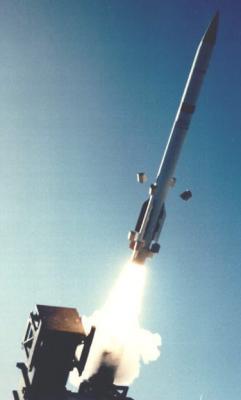Lockheed Martin Patriot PAC-3
The PAC-3 (Patriot Advanced Capability 3) missile is the ATBM (Anti Theater Ballistic Missile) component of the U.S. Army's Patriot air defense system, and will complement the existing MIM-104 Patriot missiles.
The PAC (Patriot Advanced Capability) program was begun in 1986 to develop a series of significant upgrades to the Patriot system (see the MIM-104 Patriot page for general information on Patriot and more details about the PAC program). The ultimate step is PAC-3/Configuration 3, which introduces an upgraded AN/MPQ-65 radar to increase detection in high-clutter environments, and to improve discrimination of closely spaced objects (better decoy recognition). The most important feature of this new Patriot system, however, will be a completely new missile, a variant of the Lockheed Martin ERINT (Extended Range Interceptor) commonly called PAC-3 (which is a bit confusing because the earlier PAC-3 configuration systems don't use this missile). The PAC-3 missile is highly optimized for the anti-missile role (employing a hit-to-kill capability enhanced by a fragmentation warhead), so that operational PAC-3 Patriot units will be equipped eventually with both MIM-104 and PAC-3 missiles. The latter is significantly smaller than an MIM-104, so that 16 missiles instead of four can be carried in a single launch station. ERINT was first flight-tested in 1992, and selected as the ultimate PAC-3 missile in 1994. The PAC-3/ERINT integration tests took place from 1995 to 1997, and the missile is currently in full production at Lockheed Martin Missiles And Fire Control.
 |
 | |
| Photos: U.S. Army | ||
| PAC-3 | ||
The PAC-3 is a solid-propellant rocket-powered missile controlled by both aerodynamic fins and small forebody-mounted ACM (Attitude Control Motor) rockets for increased terminal agility. For mid-course guidance it uses essentially the same TVM (Track Via Missile) guidance as the MIM-104 Patriot, but for more accurate terminal homing, it is equipped with a Ka-Band active radar seeker. The PAC-3 missile is primarily a hit-to-kill vehicle designed to knock down incoming ballistic missiles with its kinetic energy, but it is also equipped with a high-explosive fragmentation warhead to enhance the kill probability against "conventional" targets like aircraft or cruise missiles.
The operational testing phase of the PAC-3 missile began in late 2001, and Initial Operational Capability was reached in 2003 (four years after the originally planned date). Although the operational tests in the first half of 2002 were only partially successful, the PAC-3 missile was declared combat-ready in August 2002. In March 2003, it was used in combat for the first time when it intercepted Iraqi short-range SSMs during the war in the Gulf. By August 2007, Lockheed Martin had delivered 500 PAC-3 missiles to the U.S. Army.
Since 2007 Lockheed Martin is developing an improved version of the PAC-3 missile called PAC-3 MSE (Missile Segment Enhancement). This version has a more powerful rocket motor and more responsive control surfaces for an expanded flight envelope and an increased defended area. The PAC-3 MSE missile was selected as the missile component of the joint US/European Medium Extended Air Defense System (MEADS).
Designation Note: For unknown reasons, the PAC-3 missile has not received a guided missile MDS designation (MIM-nnn). Instead, it is designated in the Army Nomenclature System as Guided Missile, Aerial Intercept, M91 (with variants M91A1 through M91A9). The PAC-3 MSE missile is designated Guided Missile, Aerial Intercept, XM400.
Specifications
Note: Data given by several sources show slight variations. Figures given below may therefore be inaccurate!
Data for PAC-3:
| Length | 5.2 m (17 ft 1 in) |
| Finspan | 51 cm (20 in) |
| Diameter | 25 cm (10 in) |
| Weight | 320 kg (700 lb) |
| Speed | Mach 5+ |
| Ceiling | 15000 m (50000 ft) |
| Range | 20 km (12 miles) |
| Propulsion | Solid-fueled rocket |
| Warhead | "Hit-to-kill" + blast-fragmentation |
Main Sources
[1] Hajime Ozu: "Missile 2000 - Reference Guide to World Missile Systems", Shinkigensha, 2000
[2] Lockheed Martin Missiles and Fire Control Website
Back to Directory of U.S. Military Rockets and Missiles, Appendix 4
Last Updated: 25 June 2009